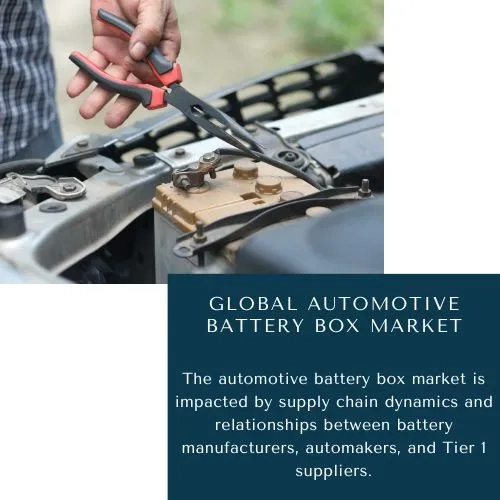AUTOMOTIVE BATTERY BOX MARKET
KEY FINDINGS
- Increasing adoption of electric vehicles is driving demand for car battery boxes worldwide. As EV manufacturers strive to improve battery safety and performance, robust and efficient batteries are becoming essential components of electric vehicle design
- The automotive industry is subject to stringent safety and regulatory standards, especially for battery technology. Battery boxes play an important role in ensuring that high-capacity lithium-ion batteries are properly insulated and operated under thermal conditions, in accordance with global safety regulations such as the UN ECE R100
- Manufacturers are increasingly incorporating lightweight but more durable materials such as aluminum alloys, high-strength steels, and composites into the manufacture of automotive battery boxes These materials help reduce vehicle weight by improving the precision and crashworthiness of the vehicle.
- Companies operating in the Automotive Battery Box market invest heavily in R&D to improve battery enclosure design, product and tool system innovation with a focus on thermal management, durability and overall performance which will be increased while optimizing weight and cost.
- Modular battery box designs are gaining popularity in the automotive industry, making them easy to integrate into vehicle platforms and the flexibility of battery systems in the design allows automakers to adapt battery boxes to battery technology and vehicles the running order matches.
- Increasing popularity of electric vehicles in regions such as North America, Europe, Asia Pacific and emerging markets is driving global demand for automotive battery boxes
- Proper thermal management and cooling systems are essential to maintain battery life and extend battery life. Vehicle battery boxes face heat dissipation challenges, especially in highly demanding driving conditions or extreme weather conditions, requiring additional cooling solutions and materials
- The automotive battery box market is impacted by supply chain dynamics and relationships between battery manufacturers, automakers, and Tier 1 suppliers. Strategic partnerships, collaboration and vertical integration in the supply chain play a key role in ensuring quality, reliability and cost-effectiveness in the battery box industry
- The global automotive battery box market is characterized by intense competition among key players and steady technological advancements. Companies are focusing on differentiation through innovative designs, advanced products and proprietary technologies to gain a competitive edge in the market.
AUTOMOTIVE BATTERY BOX MARKET OVERVIEW
The global automotive battery box market is experiencing significant growth owing to increasing demand for electric vehicles (EVs) and increasing emphasis on safety and efficiency of batteries. Battery boxes are essential components of an electric vehicle, ensuring that high-voltage lithium-ion batteries are properly insulated and heat-consumed. Strict safety and regulatory standards, including the UN ECE R100, are driving the adoption of more robust and efficient batteries.
Manufacturers are increasingly focusing on lighter and more durable materials such as aluminum alloys, high-strength steel and composite materials to optimize vehicle weight while maintaining structure integrity and crashworthiness, and investment in research and development (R&D) drives innovation in battery box designs, materials and manufacturing processes. Modular and flexible designs are gaining traction, allowing for easy integration into vehicle platforms and accommodating battery systems

The global expansion in electric vehicle production in regions such as North America, Europe, Asia Pacific, and emerging markets is fueling the demand for automotive battery boxes. Major automakers and EV-owning regions' small systems are an important goal for battery box providers. However, challenges related to heat consumption and cooling remain, requiring innovative solutions to manage heat dissipation under driving conditions
Supply chain optimization and supply chain communication play an important role in ensuring quality, reliability and cost-effectiveness in battery box manufacturing Furthermore, durability considerations sustainability leads to the adoption of environmentally friendly materials and recycling methods to minimize environmental impact throughout the product life cycle.
Intense market competition and constant technological advances emphasize the importance of differentiation through innovative design and proprietary technologies. Overall, the global automotive battery box market presents compelling growth opportunities driven by shift towards electric mobility, regulatory requirements, technological innovations and expansion of EV across the globe Policy development, innovation and collaboration in the supply chain are essential for industry stakeholders to take advantage of these opportunities and effectively address challenges.
AUTOMOTIVE BATTERY BOX MARKET INTRODUCTION
The automotive battery box serves as a critical component in electric vehicles (EVs), providing a secure housing for high-voltage lithium-ion batteries. Its primary function is to ensure the safe containment, thermal management, and protection of the battery pack, thereby safeguarding both the vehicle and its occupants. As the automotive industry undergoes a transformative shift towards electrification, the importance of battery boxes has become increasingly pronounced.
It typically consists of four primary structural pieces: the top cover, bottom cover, internal structure, and side impact crash protection structure. Design considerations include financial and weight constraints, integration options (such as cell-to-pack design or cell-to-chassis technology), material choices, and safety/sealing requirements. Innovations in battery box design continue to evolve as automakers optimize for different vehicle architectures and requirements
AUTOMOTIVE BATTERY BOX MARKET SIZE AND FORECAST

The Global Automotive Battery Box Market accounted for $XX Billion in 2023 and is anticipated to reach $XX Billion by 2030, registering a CAGR of XX% from 2024 to 2030.
AUTOMOTIVE BATTERY BOX MARKET RECENT TECHNOLOGICAL TRENDS
- Enhanced Thermal Interface Materials (TIMs): The development of advanced TIMs with high thermal conductivity and low thermal resistance properties is crucial for efficient heat dissipation within battery modules. Graphite-based TIMs, phase change materials (PCMs), and carbon nanotube-enhanced TIMs are emerging as promising solutions to improve thermal management in battery boxes.
- Integrated Cooling Plates: Cooling plates integrated into the battery box design facilitate direct thermal contact with battery cells, enabling efficient heat transfer and uniform temperature distribution. Microchannel and finned cooling plate configurations enhance heat dissipation and minimize temperature gradients, optimizing battery performance and longevity.
- Active Thermal Runaway Mitigation Systems: Active thermal management systems employ sophisticated algorithms and control mechanisms to detect and mitigate thermal runaway events in real time. Rapid cooling methods, such as liquid immersion cooling and vapor-phase refrigeration, are deployed to rapidly reduce battery temperatures and prevent catastrophic failure.
- Electromagnetic Interference (EMI) Shielding: As battery boxes contain sensitive electronics and communication systems, effective EMI shielding solutions are essential to minimize electromagnetic interference and ensure reliable operation. Conductive coatings, metallized films, and ferrite-based materials are employed to attenuate electromagnetic radiation and preserve signal integrity.
- High-Voltage Isolation and Insulation: Given the high-voltage nature of electric vehicle battery systems, stringent isolation and insulation measures are implemented within battery boxes to prevent electrical faults and ensure personnel safety. Dielectric materials, such as ceramics and polymeric insulators, are employed to provide robust electrical insulation and withstand high-voltage stresses.
- Automated Manufacturing Processes: Advances in automated manufacturing technologies, including robotic assembly, additive manufacturing, and laser welding, enable high precision and repeatability in the production of battery boxes. Automated quality control systems, such as machine vision inspection and non-destructive testing, ensure compliance with stringent safety and performance standards.
AUTOMOTIVE BATTERY BOX MARKET RECENT LAUNCHES
PowerTech Solutions introduced thePowerGuard Pro Series,the latest innovation in automotive battery box technology. Designed to meet the growing demand for high-performance, durable, and safe battery enclosures, the PowerGuard Pro Series sets a new standard for excellence in automotive energy storage solutions.
Featuring advanced materials and construction techniques, the PowerGuard Pro Series offers exceptional strength, impact resistance, and thermal management capabilities to protect batteries from harsh operating conditions and environmental factors.
With customizable configurations and integrated safety features, including fire-resistant materials and thermal sensors, the PowerGuard Pro Series ensures reliable performance and peace of mind for vehicle manufacturers and end-users alike. Whether for electric vehicles, hybrid vehicles, or energy storage applications, the PowerGuard Pro Series delivers unmatched quality, reliability, and safety in automotive battery enclosures.
BatteryTech launched EcoShield EV Series, the latest line of environmentally friendly battery enclosures for electric vehicles. Engineered with sustainability in mind, the EcoShield EV Series features innovative design elements and eco-friendly materials to minimize environmental impact while maximizing performance and safety.
Utilizing recycled plastics and bio-based composites, the EcoShield EV Series offers lightweight yet durable protection for vehicle batteries, reducing overall vehicle weight and improving energy efficiency. With advanced thermal management systems and passive cooling technologies, the EcoShield EV Series ensures optimal battery performance and longevity in all driving conditions.
Designed for compatibility with a wide range of electric vehicle platforms, the EcoShield EV Series provides a versatile and sustainable solution for automotive OEMs seeking to accelerate the transition to electric mobility while minimizing their carbon footprint.
SecurePower Systems introduced the SafeGuard HDX Series, the latest generation of heavy-duty battery enclosures designed for commercial and industrial applications. Built to withstand the rigors of demanding operating environments, the SafeGuard HDX Series offers rugged durability, superior protection, and unmatched reliability for large-scale energy storage systems.
Constructed from high-strength steel and reinforced with impact-resistant coatings, the SafeGuard HDX Series provides robust defense against mechanical damage, vibration, and external hazards, ensuring uninterrupted power supply and operational continuity in critical infrastructure applications.
With customizable configurations and modular design features, the SafeGuard HDX Series offers flexibility and scalability to meet the evolving needs of commercial and industrial customers, from backup power systems to renewable energy integration projects. Designed for easy installation and maintenance, the SafeGuard HDX Series delivers peace of mind and confidence in the reliability of your energy storage infrastructure.
AUTOMOTIVE BATTERY BOX MARKET SEGMENTATION
By Type of Vehicle
- Passenger cars
- Commercial vehicles
- Electric vehicles (EVs)
By Material Type
- Metal (aluminum, steel),
- Composite materials (carbon fiber-reinforced polymers)
- Plastic
By Battery Chemistry:
- Lithium-ion batteries (Li-ion)
- Nickel-metal hydride (NiMH) batteries
- Lead-acid batteries
By Geography
- North America
- Europe
- China
- Asia Ex China
- ROW
AUTOMOTIVE BATTERY BOX MARKET COMPANY PROFILES
- LG Chem
- Panasonic Corporation
- Samsung SDI
- BYD Company Limited
- Contemporary Amperex Technology Co. Limited (CATL)
- Toshiba Corporation
- Hitachi Chemical Co., Ltd.
- Johnson Controls International PLC
- A123 Systems LLC
- GS Yuasa International Ltd.
AUTOMOTIVE BATTERY BOX MARKET REPORT WILL ANSWER THE FOLLOWING QUESTIONS
- What are the key drivers propelling the growth of the global automotive battery box market?
- How does the increasing demand for electric vehicles (EVs) impact the automotive battery box market?
- What role does government regulation and policy play in shaping the automotive battery box market?
- What are the latest technological advancements in automotive battery box design and manufacturing?
- How does the trend towards lightweighting in the automotive industry affect the design and materials used in battery boxes?
- What are the key challenges facing manufacturers in the automotive battery box market, such as cost, safety, and compatibility?
- How is the market segmented based on vehicle type, battery type, and region?
- What are the emerging trends in automotive battery box integration, such as modular designs and thermal management systems?
- How do automotive battery box suppliers ensure compliance with safety standards and regulations?
- What are the key opportunities for innovation and growth in the automotive battery box market, such as advancements in materials and manufacturing processes?
- How do automotive OEMs and tier-1 suppliers collaborate in the development and production of battery boxes?
- What are the potential implications of battery box recycling and sustainability initiatives on the market?
- How does the shift towards electrification and autonomous driving impact the demand for automotive battery boxes?
- What are the market dynamics affecting the pricing and profitability of automotive battery box manufacturers?
- How do automotive battery box suppliers differentiate their products in a competitive market landscape?
- What are the key strategic partnerships and collaborations among automotive battery box manufacturers and other industry stakeholders?
- How does the adoption of advanced manufacturing technologies, such as additive manufacturing and automation, impact the automotive battery box market?
- What are the growth prospects for the global automotive battery box market in the short, medium, and long term?
- How does the market for battery electric vehicles (BEVs) versus hybrid electric vehicles (HEVs) influence the demand for automotive battery boxes?
- What are the implications of geopolitical factors, such as trade policies and raw material sourcing, on the automotive battery box market?



